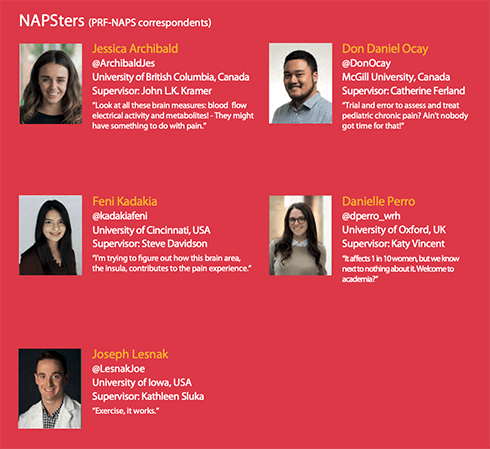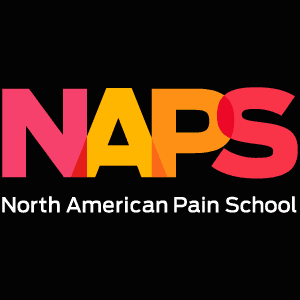Five early-career pain researchers are participating in the PRF-NAPS Correspondents program during the 2022 North American Pain School, taking place from 19-24 June in Montebello, Québec City, Canada. The Correspondents program is a unique science communication training program that provides participants with knowledge and skills needed to communicate science effectively to a wide range of pain researchers, patients, and the greater public. The Correspondents will conduct interviews with NAPS Visiting Faculty and Patient Partners, write summaries of scientific lectures – and provide live blogging, too! Take a look at their blog posts from the first full day at NAPS below.
NAPS Blog Posts: Day 1
Come for the Science, Stay for the NAPSters
Day 1 at NAPS: A Tale of Nostalgia, Publishing, and Perseverance
Preclinical Research Mistakes Have Been Made, But It’s Not Too Late!
What stops you from writing that first draft? Is it the feeling that your next paper must be your magnum opus? The feeling that everyone you know – colleagues, current supervisors, potential collaborators – will read this draft and form an opinion based on every word you say?
Going into anything with this perspective paralyzes even the best of us. Today at NAPS, we discussed the idea of a “terrible first draft.” What if we approached the first draft of anything this way, be it a paper, a grant proposal, or a presentation outline? Let’s start by knowing that there will be mistakes and room for improvement. The faster we can get past that point of staring at a blank screen, the sooner we can start crafting and shaping what we need to say and share.
In the software developer world, they call this, “Test at Your Desk.”I encourage you to send in that “rough, imperfect, dirty” draft and test if that idea or premise is working. If it’s not, you’ll find out quickly, and can go back to the drawing board. Perhaps this will be more time efficient. More importantly, perhaps it will even be more enjoyable.
Jessica Archibald is a PhD candidate at the University of British Columbia, Canada. You can follow her on Twitter – @ArchibaldJes
Come for the Science, Stay for the NAPSters
The first full day of NAPS has been packed full of amazing presentations, both from Visiting Faculty and trainees. It is so energizing to hear everyone give enthusiastic presentations about their research.
Mark Jensen, PhD (University of Washington, US), provided us with tips on getting research published, along with an informative top 10 list exploring why manuscripts are rejected. Jennifer Haythornthwaite, PhD (Johns Hopkins University School of Medicine, Baltimore, US), then gave an engaging interactive presentation on how to improve mentor-mentee relationships.
The best part of NAPS so far, however, has been meeting everyone. I have been able to connect with interesting young researchers from around the world. I’ve been particularly impressed with how many students have traveled from Europe and Australia to attend. I hope that these relationships continue to build over the coming days, and last a lifetime.
Finally, it has been great getting closer with the Visiting Faculty. This small group setting is the perfect opportunity to have more in-depth, personal conversations, which are difficult to have during higher-attendance meetings. I even had the opportunity to get humiliated in tennis by Ted Price, PhD (University of Texas at Dallas, US).
All in all – the science has been stimulating, and I’m enjoying these connections and relationships I’ve been able to form. I cannot wait for the next couple of days.
Joseph Lesnak, DPT, is a PhD candidate at the University of Iowa, US. You can follow him on Twitter – @LesnakJoe.
How does one describe the first full day of NAPS? WOW! Who knew that doing yoga before the start of a conference day could be so relaxing? I learned that chanting “ohm” is used to calm the mind and create a peaceful setting, while chanting “shanti” at the end of yoga practice is used to invoke inner peace. I think it was useful to prepare the mind for an intense day filled with vibrant discussions.
What really fascinated me today were the presentations from my fellow NAPSters. Seeing the diversity of our projects – both inside and outside of my expertise – sparked many ideas and created the incentive to approach my peers. Doing so has allowed me to learn more about their research and find a common goal around which we can potentially collaborate. The intimate setting and spending so much time together really “gets the gears turning” to set up lifelong friendships.
A very interesting workshop was presented by Jennifer Haythornthwaite, focused on, “Making the Most of Mentors.” I’d like to add that this presentation was given while I ate staple Canadian desserts, such as pouding chômeur, sugar tarts, maple syrup crêpes, and tire d’érable. My main takeaway from Jennifer’s presentation was that we should have a mentoring village – mentors that guide us in our research, but also our academic/career development. Furthermore, we should have mentors both inside and outside our institutions, and even peer mentors!
Considering this was only the first full day of NAPS, I am excited for the rest of the week!
Don Daniel Ocay is a PhD candidate at McGill University, Montreal, Canada. You can follow him on Twitter – @DonOcay
Day 1 at NAPS: A Tale of Nostalgia, Publishing, and Perseverance
Today was the best kind of Monday – early morning yoga, making new friends, and hearing from incredible pain researchers and trainees about their work. It was that kind of Monday when you don’t roll out of bed and think, “I wish I had another day of the weekend!” While I wish that my jet lag wasn’t making me sleepy during dinner, the first full day of NAPS was nothing short of amazing.
After being introduced to the NAPS Executive Committee, Mark Jensen walked us through the publishing process at The Journal of Pain. As convoluted as academic publishing can be, Mark’s mapping of the process was a comfort. After pointing out to us where many unpublishable articles go wrong, he made me consider some of the primary reasons why people don’t get published in high-impact journals – is your study adequately innovative, and are you designing/contributing to highly novel, intriguing research?
Aside from pain, the most common word used at NAPS that starts with the letter P is perseverance. As an international student studying in the UK, perseverance resonates with my experience (and I’m sure it does for every pain trainee here). The rejections, the late nights in the lab, the computer code that doesn’t work … perseverance is how you make it through these challenges.
I’d like to thank Jennifer Haythornthwaite for her mentoring workshop as well. While challenges in academia are inevitable, the right mentors who have your best interests at heart make those challenges less daunting.
I finished the day feeling simultaneously energized, exhausted, and with a “sugar high” after dessert and s’mores around the campfire. It’s great to be back in Canada this week, and so much sweeter to be here with all of the NAPSters. Bring on day two!
Danielle Perro is a fourth-year PhD candidate at the University of Oxford, UK. You can follow her on Twitter – @dperro_wrh
Preclinical Research Mistakes Have Been Made, But It’s Not Too Late!
The first full day of NAPS did not disappoint. The talks from the Executive Committee, Visiting Faculty, and the NAPSters were nothing short of amazing. According to Jeff Mogil, PhD (McGill University, Montreal, Canada), however, mistakes have been made in preclinical research, and that’s what stuck out for me. For context, I learned that these mistakes have led to failed therapeutics in many clinical trials. Here are some reasons why:
1. Most of the mice used in basic science research are inbred, due to the assumption they will produce less variance. Is this true? Actually, no. There isn’t much evidence to support that inbred mice produce less variance than outbred mice. It turns out there might not be a benefit to using inbred mice (think about why human inbreeding is taboo!).
2. The majority of patients in pain are women; however, a majority of researchers use male mice. There are clear sex differences that emerge when using male and female rodents in pain studies (e.g., neuroimmune mechanisms of pain), and there are inevitably more sex differences in pain processing that have yet to be discovered.
3. Chronic pain is defined as pain that persists for greater than three months. In the lab, however, rodent models of chronic pain do not experience pain along a timeline that effectively translates to humans. Interestingly, there are also sex-dependent effects of long-term pain on lifespan. There may be important data basic scientists are missing when they conduct animal experiments too soon after inducing injury.
These are just a few of my takeaways from the first full day at NAPS, and I will definitely keep them in mind the next time I design an experiment!
Feni Kadakia is a PhD student at the University of Cincinnati, Ohio, USA. You can follow her on Twitter – @KadakiaFeni
The 2022 PRF-NAPS Correspondents




